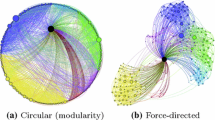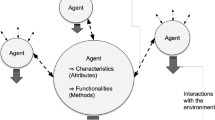Abstract
The concept of affinity relationship discovery is relatively new in the context of online discussion communities and there has been little work addressing it to date. This problem entails finding affinity relationships in a community by combining structural features and the content of interactions. Affinity discovery seeks not only to identify these affinity relationships, but also to quantify them so that the degree of affinity between individuals can be perceived in the form of a score. This paper proposes an algorithm based on Markov chain models, named HAR-search, for discovering hidden affinity relationships and deriving affinity scores between individuals in an online community. We demonstrate that our method is capable of tracking the evolution of affinity over time and predicting affinity relationships arising from the influence of certain community members. Comparison with state-of-the-art methods shows that our method results in robust discovery and considers minute details.



Similar content being viewed by others
Notes
This means that W actors may help V actors go beyond the boundaries by not limiting themselves exclusively to the clusters of V actors, but also opening up to W clusters.
References
Abbott R, Ecker B, Anand P, Walker MA (2016) Internet argument corpus 2.0: an SQL schema for Dialogic social media and the corpora to go with it. In: Proceedings of LREC, pp 4445–4452
Aiello LM, Barrat A, Schifanella R, Cattuto C, Markines B, Menczer F (2012) Friendship prediction and homophily in social media. ACM Trans Web 6(2):1–33
Avrachenkov K, Litvak N, Pham KS (2007) Distribution of pagerank mass among principle components of the web. In: Proceedings of WAW 2007, pp 16–28
Baras D, Ronen A, Yom-Tov E (2014) The effect of social affinity and predictive horizon on churn prediction using diffusion modeling. Soc Netw Anal Min 4:232. https://doi.org/10.1007/s13278-014-0232-2
Brânzei S, Larson K (2009) Coalitional affinity games and the stability gap. In: Proceedings of the twenty-first international joint conference on artificial intelligence, pp 79
Cambria E, Poria S, Bajpai R, Schuller B (2016) SenticNet 4: a semantic resource for sentiment analysis based on conceptual primitives. In: Proceedings of COLING 2016, pp 2666–2677
Cheng J, Danescu-Niculescu-Mizil C, Leskovec J (2015) Antisocial behavior in online discussion communities. In: Proceedings of the 9th ICWSM, pp 60–70
Chikhaoui B, Chiazzaro M, Wang S (2011) An Improved hybrid recommender system by combining predictions. In: Proceedings of WAINA 2011, pp 644–649
Chikhaoui B, Chiazzaro M, Wang S (2015) A new granger causal model for influence evolution in dynamic social networks: the case of DBLP. In: Proceedings of AAAI 2015, pp 51–57
Devlin J, Chang MW, Lee K, Toutanova K (2019) Bert: pre-training of deep bidirectional transformers for language understanding. In; Proceedings of North American Association for computational linguistics (NAACL)
Dey K, Majumdar S (2015) Customer sentiment analysis by tweet mining: unigram dependency approach. IJCSE 6(4):124–129
Dhaneriya R, Ahirwar M, Motwani M (2016) Unigram polarity estimation of movie reviews using maximum likelihood. Int J Comput Sci Issues 13(5):120–124
Guibon G, Ochs M, Bellot P (2016) From emojis to sentiment analysis. In: WACAI’16, pp hal–01529708
Hajian S, Tassa T, Bonchi F (2016) Individual privacy in social influence networks. Soc Netw Anal Min 6:2. https://doi.org/10.1007/s13278-015-0312-y
Hamilton WL, Clark K, Leskovec J, Jurafsky D (2016) Inducing domain-specific sentiment lexicons from unlabeled corpora. ArXiv preprint arXiv:1606.02820
Hee CV, Jacobs G, Emmery C, Desmet B, Lefever E, Verhoeven B, De Pauw G, Daelemans W, Hoste V (2018) Automatic detection of cyberbullying in social media text. PLOS One 13(10):e0203794
Herdag̃delen A, State B, Adamic L, Mason W (2016) The social ties of immigrant communities in the United States. In: Proceedings of the 8th ACM conference on web science, pp 78–84
Hong M, Jung JJ, Lee M (2016) Social affinity-based group recommender system. In: ICCASA 2015: context-aware systems and applications, pp 111–121
Hu M, Liu M (2004) Mining and summarizing customer reviews. In: Proceedings of KDD’04, pp 168–177
Huang Q, Singh VK, Atrey PK (2014) Cyber bullying detection using social and textual analysis. In: Proceedings of SAM’14, pp 3–6
Jiao QJ, Huang Y, Liu W, Wang XF, Chen XS, Shen HB (2013) Revealing the hidden relationship by sparse modules in complex networks with a large-scale analysis. PLoS One 8(6):e66020
Kachapova F (2013) Representing markov chains with transition diagrams. J Math Stat 9(3):149–154
Kim M, Park SO (2011) Group affinity based social trust model for an intelligent movie recommender system. J Multimed Tools Appl 64(2):505–516
Klein AZ, Sarker A, Rouhizadeh M, O’Connor K, Gonzalez G (2017) Detecting personal medication intake in twitter: an annotated corpus and baseline classification system. In: Proceedings of the BioNLP, pp 136–142
Landwehr N, Hall M, Frank E (2003) Logistic model trees. In: Proceedings of the 14th European conference on machine learning, pp 241–252
Laudy C (2015) Hidden relationships discovery through high-level information fusion. In: Proceedings of 18th international conference on information fusion, pp 916–923
Luebker M (2019) Can the structure of inequality explain fiscal redistribution? Revisiting the social affinity hypothesis. In: LIS Working papers 762
Mikolov T, Sutskever I, Chen K, Corrado G, Dean J (2013) Distributed representations of words and phrases and their compositionality. In: Proceedings of NIPS’13, pp 3111–3119
Miller H, Kluver D, Thebault-Spieker J, Terveen L, Hecht B (2017) Understanding emoji ambiguity in context: the role of text in emoji-related miscommunication. In: Proceedings of the 11th ICWSM, pp 152–161
Panigrahy R, Najork M, Xie Y (2012) How user behavior is related to social affinity. In: Proceedings of the 5th ACM international conference on Web search and data mining, pp 713–722
Purohit H, Ruan Y, Fuhry D, Parthasarathy S, Sheth A (2014) On understanding the divergence of online social group discussion. In: Proceedings of the 8th ICWSM, pp 396–405
Podobnik V, Lovrek I (2015) Implicit social networking: discovery of hidden relationships, roles and communities among consumers. In: Proceedings of 19th international conference on knowledge-based and intelligent information and engineering systems, procedia computer science, vol 60, pp 583–592
Rafiq RI, Hosseinmardi H, Han R, Lv Q, Mishra S (2018) Scalable and timely detection of cyberbullying in online social networks. In: Proceedings of SAC’18, pp 1738–1747
Razavi AH, Inkpen D, Uritsky S, Matwin S (2010) Offensive language detection using multilevel classification. In: Proceedings of the 23rd Canadian conference on advances in artificial intelligence, pp 16–27
Rezgui A, Fahey D, Smith I (2016) Affinityfinder: a system for deriving hidden affinity relationships on twitter utilizing sentiment analysis. In: Proceedings of the 4th international conference on future internet of things and cloud workshops, pp 212–215
Sawhney K, Prasetio MC, Paul S (2017) Community detection using graph structure and semantic understanding of text. SNAP Stanford University. http://snap.stanford.edu/class/cs224w-2017/projects/cs224w-75-final.pdf. Accessed 19 Mar 2019
Seufert M, Hoßfeld T, Schwind A, Burger V, Tran-Gia P (2016) Group-based communication in whatsapp. In: Proceedings of 2016 IFIP networking conference (IFIP networking) and workshops, pp 536–541
Shih YK, Parthasarathy S (2012) Identifying functional modules in interaction networks through overlapping markov clustering. Bioinformatics 28(18):473–479
Skalny P (2014) An application of graph theory in markov chains reliability analysis. Adv Electr Electron Eng 12(2):154–159
Sless L, Hazon N, Kraus S, Wooldridge M (2014) Forming coalitions and facilitating relationships for completing tasks in social networks. In: Proceedings of the 2014 international conference on autonomous agents and multi-agent systems, pp 261–268
Smith LM, Zhu L, Lerman K, Kozareva Z (2014) The role of social media in the discussion of controversial topics. In: Proceedings of 2013 international conference on social computing, pp 236–243
Song M, Lee W, Kim J (2010) Extraction and visualization of implicit social relations on social networking services. In: Proceedings of the twenty-fourth AAAI conference on artificial intelligence, pp 1425–1430
Taheri SM, Mahyar H, Firouzi M, Ghalebi E, Grosu R, Movaghar A (2017) Extracting implicit social relation for social recommendation techniques in user rating prediction. In: Proceedings of the 26th international conference on world wide web companion, pp 1343–1351
Topal K, Koyutürk M, Özsoyoğlu G (2017) Effects of emotion and topic area on topic shifts in social media discussions. Soc Netw Anal Min 7:46. https://doi.org/10.1007/s13278-017-0465-y
Tshimula JM, Chikhaoui B, Wang S (2019) HAR-search: a method to discover hidden affinity relationships in online communities. In: Proceedings of 2019 IEEE/ACM international conference on advances in social networks analysis and mining, pp 176–183
Wolny W (2016) Emotion analysis of twitter data that use emoticons and emoji ideograms. In: Proceedings of 25th international conference on information systems development, pp 476–483
Xiang R, Neville J, Rogati M (2010) Modeling relationship strength in online social networks. In: Proceedings of the 19th international conference on world wide web, pp 981–990
Yang CC, Tang X, Dai Q, Yang H (2013) Identifying implicit and explicit relationships through user activities in social media. Int J Electron Commer 18(2):73–96
Zhang AX, Culbertson B, Paritosh P (2017) Characterizing online discussion using coarse discourse sequences. In: Proceedings of the eleventh international AAAI conference on web and social media, pp 357–366
Zhou W, Duan W, Piramuthu S (2014) A social network matrix for implicit and explicit social network plates. Decis Support Syst 68(C):89–97
Author information
Authors and Affiliations
Corresponding author
Additional information
Publisher's Note
Springer Nature remains neutral with regard to jurisdictional claims in published maps and institutional affiliations.
Rights and permissions
About this article
Cite this article
Tshimula, J.M., Chikhaoui, B. & Wang, S. A new approach for affinity relationship discovery in online forums. Soc. Netw. Anal. Min. 10, 40 (2020). https://doi.org/10.1007/s13278-020-00644-9
Received:
Revised:
Accepted:
Published:
DOI: https://doi.org/10.1007/s13278-020-00644-9




